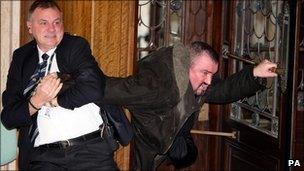Loyalist killer Stone's Stormont attack: verdict upheld
- Published

Michael Stone being restrained during the attack at Stormont in November 2006
Loyalist killer Michael Stone has failed in his attempt to overturn convictions for trying to assassinate Gerry Adams and Martin McGuinness.
The Court of Appeal upheld a verdict that his actions at Stormont in November 2006 were capable of constituting an attempt to murder them.
Stone pointed a gun at a security guard who discovered him writing graffiti on the pillars at Parliament Buildings.
He claimed he was engaged in performance art.
Stone was jailed for 16 years for the attempted murders and other offences including possessing explosives.
Lord Chief Justice Sir Declan Morgan said Stone had used explosives to create a diversion which would enable him to enter the Assembly chamber and seek out his targets.
Sir Declan said: "We are satisfied that the lighting of a fuse can be said to be part of the execution or implementation of the plan to kill Mr Adams and Mr McGuinness and thereby more than merely preparatory to the implementation of that plan.
"We express no view on whether the acts preceding the lighting of the fuse were sufficient."
Explosive fireworks
Stone claimed to have been engaged in an act of performance art when he went to Stormont on the day Ian Paisley and Mr McGuinness were due to be nominated as Northern Ireland's First and Deputy First Ministers.
He was armed with knives, an axe, garrotte and a flight bag containing explosive fireworks, flammable liquids, a butane gas canister and fuses.
Stone, who suffers from hereditary motor neuropathy, was overpowered after trying to ignite the bag and throw it into the main foyer.
He was shouting remarks about Sinn Fein and Mr Paisley and "no power sharing with IRA".
Following his arrest Stone, who was wearing a flak jacket, told police he had planned to enter the debating chamber at Stormont, use a smoke bomb as a diversion, and then slit the throats of Mr Adams and Mr McGuinness.
Eight devices were discovered, with explosives experts declaring some of them capable of injuring anyone standing within five to ten metres. Another could have created a fireball capable of causing severe burns.
At his trial he claimed to have no intention to kill anyone, but said he did not use innocuous substances because he wanted to be taken seriously.
According to his account the nails in the devices were symbols of "nailing the truth", while a fisherman's knives and hat were used in apparent reference to Mr McGuinness' former nickname, the Fisherman.
'Performance art'
Stone had written two letters to journalists stating that by the time they received them he would either be in jail for the rest of his life or, more probably, dead, because he was set on his mission to assassinate Mr Adams and Mr McGuinness.
He claimed to have written a third letter to the then PSNI Chief Constable Sir Hugh Orde describing his intention to carry out a form of performance art.
Appealing the convictions for attempted murder and possession of explosive substances with intent, his lawyers argued that he knew any attempt to kill the pair would be impossible.
They instead claimed his foiled bid to get into Parliament Buildings was the action of "a sad attention-seeker out of touch with reality".
Stone's frail physical condition was emphasised, with judges told it took him two hours to make the mile-long walk from the gates of Stormont.
But delivering judgment alongside Lord Justices Higgins and Girvan, Sir Declan pointed out how Stone made a series of false claims. These included taping over the fuses, using an empty gas canister, and only having heating oil in his bag.
Stone's assertions that his letters to journalists were to add to the drama of the performance and increase coverage of the event were also rejected.
"These letters would not have been received until the following morning by which time, if he was correct in his evidence, they would have been demonstrably false," the judge said.
Truth will out
"In those circumstances they could not have added to any performance."
Dealing with Stone's intentions, Sir Declan added: "The fact that some of the items in his possession had been painted or improvised did not take away from the evidence pointing to his intention to kill and cause serious injury.
"We do not consider that the conclusion of the learned trial judge on this issue is open to criticism."
Stone's assault on Stormont came six years after he was released early from a life sentence under the terms of the Good Friday Agreement.
He had been jailed for a 1988 gun and grenade attack on an IRA funeral at Milltown Cemetery, west Belfast in which three men were killed.
Stone sat impassively throughout today's judgment after being escorted into court on a walking stick.
Before being returned to custody he shouted: "The truth will out, gentlemen, believe me."